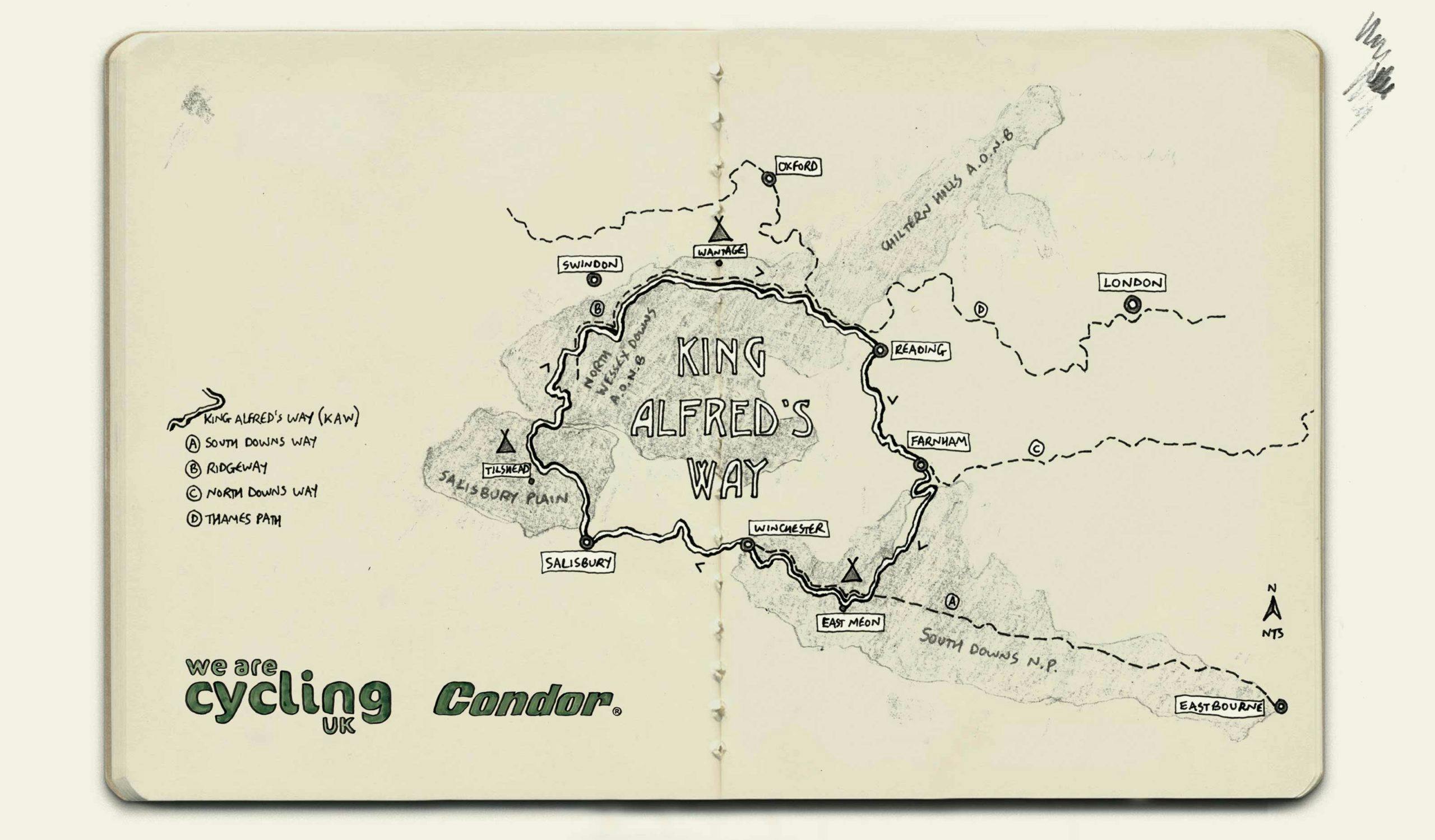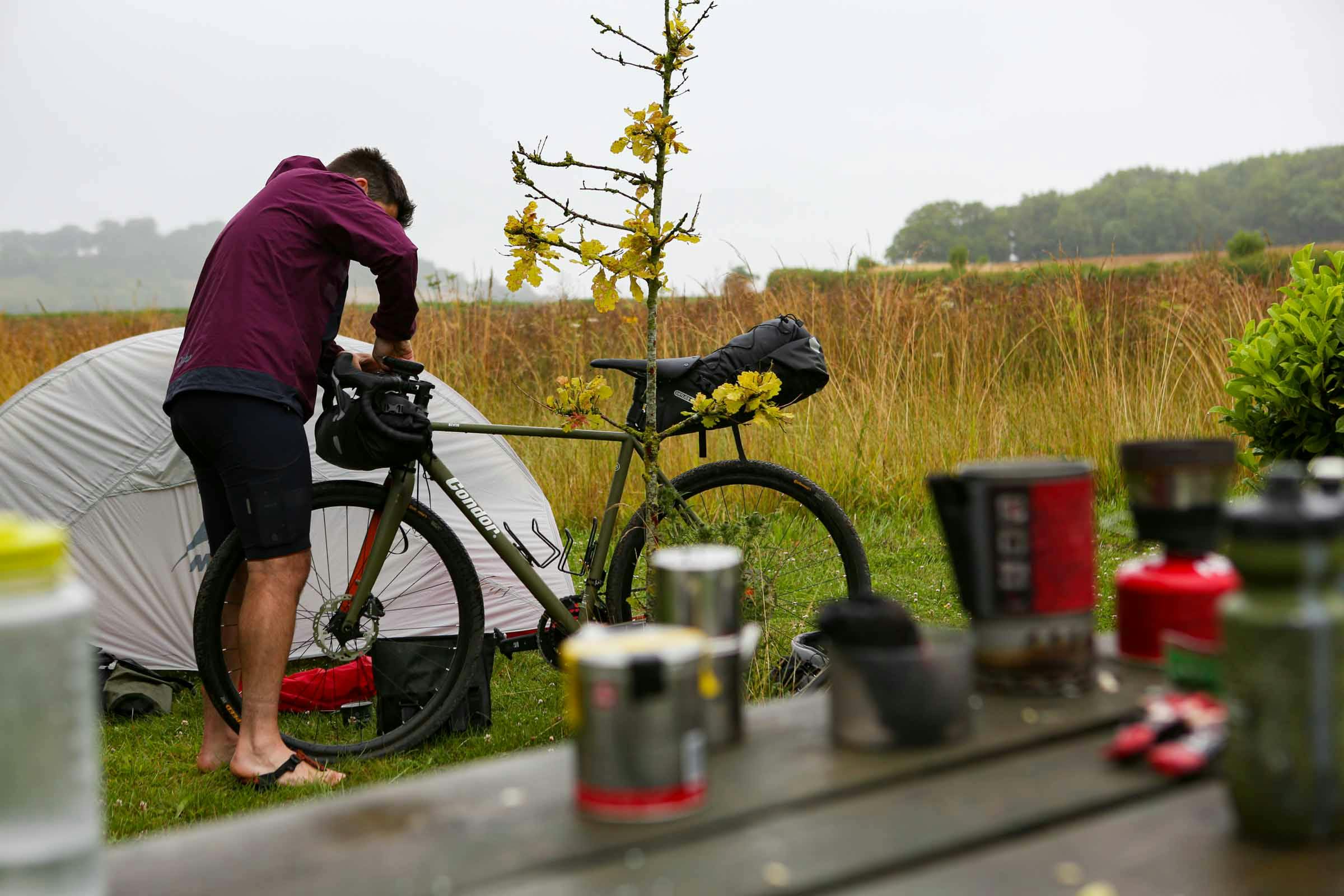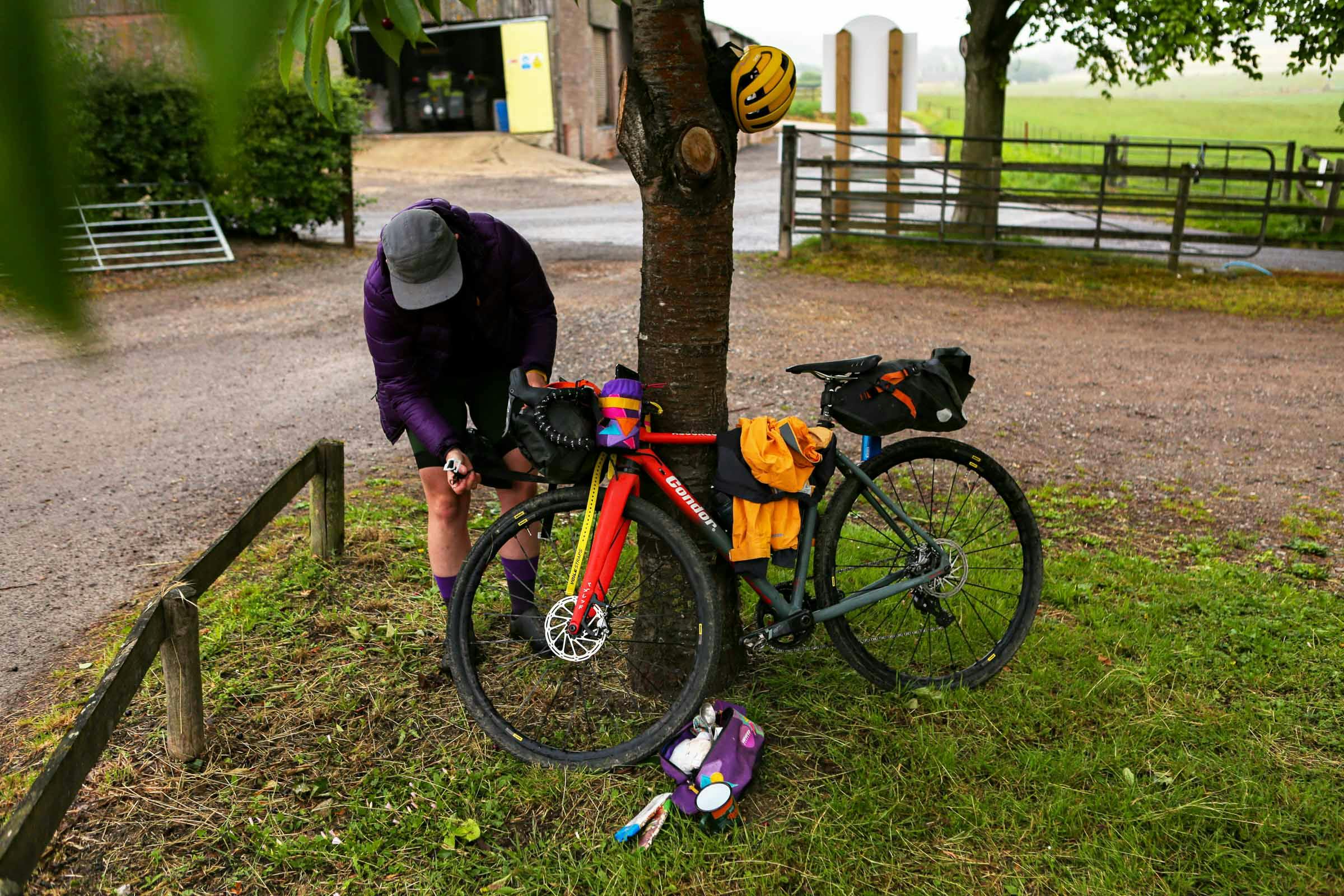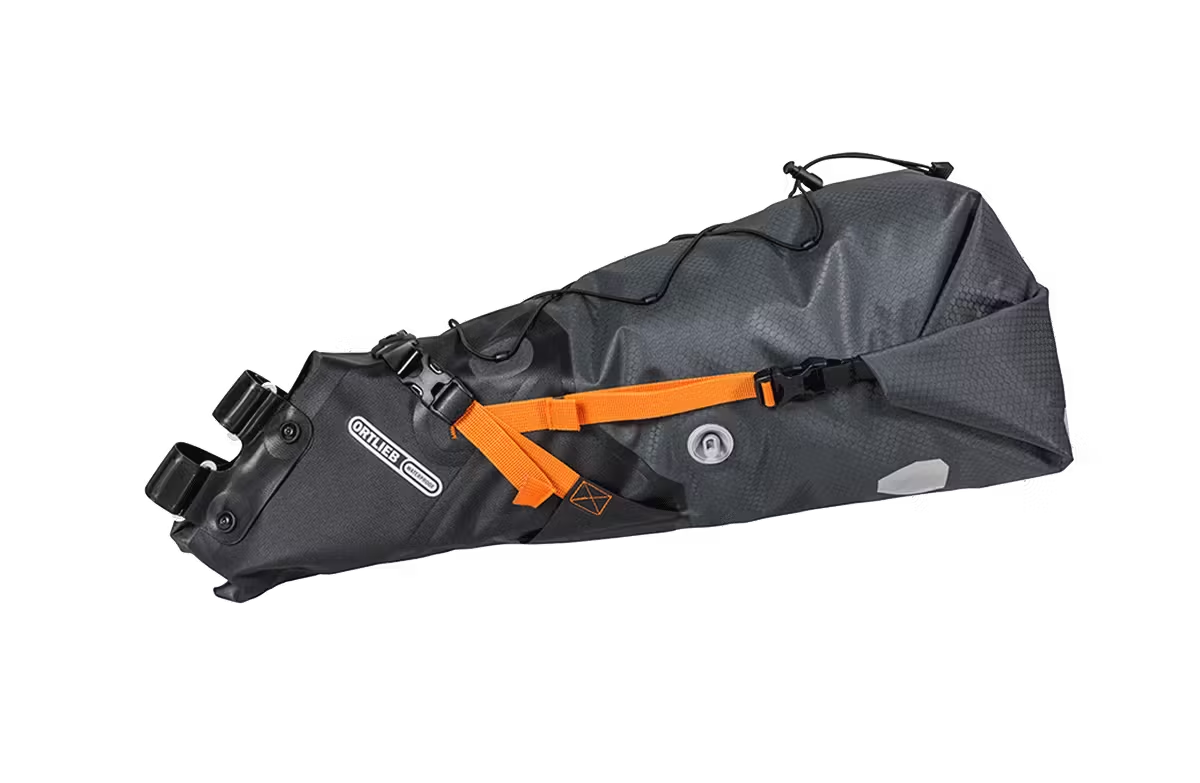
King Alfred’s Way / King Alfred’s Way – Route Guide
Condor Cycles – Gravel / Adventure bikes
The Izaak Walton was buzzing. One of two pubs in East Meon – a small thatched village sunk in one of the lush green river valley oases off the South Downs Way. ‘Twas the first evening of our four day bikepack and a great sight; of relief to be honest. Riding out of Covid, into the first week of being allowed to ride multi-day trips, was a big unknown.
Sam, Sophie, Katherine, Dave and I cheers-ed, without clinking, to a fantastic first 80KM out of Farnham – along sandy heath tracks, wheat-lined chalky singletrack and furrowed flint paths, past telephone box libraries and trike-touring cycling groups quenching their thirst, too, through the pub windows dotted along our Surrey lanes. A bitter shandy here, in the distanced company of locals and several other cyclists, then the five of us would ride on a couple more kilometres to set up camp at the local fly-fishery, before rustling up a mushroom risotto.
Sat outside the pub that first evening, all I knew was that it was glorious to be riding, and adventuring by bike with friends old and new, again. Local, accessible adventure close to home has been more than a theme during the Covid-Lockdown months and, now, we were out there – in a somewhat untapped area of England that’s within an hour’s journey for 17 million people…



Shallow horizons saturated with vivid greens, yellows, punctured gravel lines and big skies is my long-lasting memory of riding through Wessex. Discovering the wide, rolling upland and fertile lowland plains of King Alfred’s Way really was a journey through time and place; our tyre tracks never far from millennia of human history.
The five of us were lucky enough to be the first to ride Cycling UK’s new 350-kilometre off-road bikepacking route around the heart of historic Wessex via iconic sights like Stonehenge and Avebury Stone Circles, and Winchester and Salisbury Cathedrals. The Charity (previously CTC – Cyclist’s Touring Club) have spent three years curating the route – stitching together sections of existing cycling trails you might have heard of like the Ridgeway, South and North Downs Way, and Thames Path, with quiet touring lanes, bridleways and byways. They even negotiated with the Ministry of Defence (MOD) and worked to upgrade certain sections of footpath to forge this ace, challenging ride through an ever-changing landscape. The new bikepacking route is named after Alfred The Great – the 9th Century Saxon King born in Wantage (848AD) and buried in Winchester (899AD) – whose leadership, victories and reforms would transform Wessex into the most powerful kingdom in Britain…







Hold on, what even is Wessex? ‘Wessex’ derives from ‘Kingdom of the West Saxons’ whose bounds today would include the counties of Hampshire, Wiltshire, Dorset, and some of Surrey and Berkshire – a chalky, fertile downland region that man has called home since around 4000BC. Along the route, we’d be riding with the Neolithic people amongst their long barrow burial sites and ancient temples, with the Iron Age folk up their steep earthwork hill forts, and follow Drovers and Turnpikes along moody hollows. Some slithers of bygone byways feeling that they hadn’t been ridden or trod since the era of King Alfred. Wessex, today, is traditional, quintessential English touring country littered with off-road adventure trails – making for a great mix of wild and mild. You’re never too far from a village green, church, inn, or village store. Sure, Wessex’s landscapes have been tamed but sometimes “the comfort and homeliness of a countryside in which man has always been at home” makes for a fun, easy escape and adventure by bike. It hasn’t always been that way of course…
In prehistoric times, most routeways were simple natural tracks – not so much constructed as slowly emerged in the landscape, trod by migrating animals “through upland passes, along ridgeways and across rivers at the most easily fordable places”. These longer-distance tracks developed as groups of animals joined or left the main ones, upon which hunter-gatherers around 5000BC slowly began influencing as they followed them, hunted along them, and eventually modified for themselves. With changing climates, the increasing use of fire, tools, domestication of animals and rise in trading (especially in metals like iron, copper, gold and tin), forest cover was chopped away and areas of downland, heath and moorland grew to allow greater access for a growing network of tracks and communication lines. By the end of Prehistoric Times the “British Isles, apart from the highest and most inhospitable hills, were criss-crossed by trackways.” Following the Iron Age Celts and Romans, the Saxons (and era of King Alfred himself) was a time when Britain was organised into kingdoms which, for economic, administrative, and military reasons were developing further established, longer-distance network of communication lines. However, as industrialisation took hold, it was apparently the area’s lack of iron and coal that shifted power away from Winchester. In a good way. Wessex’s meadowland, woodland, heath and moorland remained home to farmland rather than industry, which helped forge such a changing experience of riding landscape today – from flint-furrowed ridgeway tracks to ancient woodland singletrack, from golden grain-field gravel to sandy heathland bridleways, from grand cathedrals to humble thatched cottages…













If Wessex was the heart of England, “the heart of Wessex must be Avebury and Stonehenge.” Once the land of primeval farmers, whose stone circle temples were the equivalent of Westminster Abbey today, Avebury is now a key historical and logistical point along the King Alfreds Way route – sited at the start of The Ridgeway section. The village is also home to a National Trust cafe (where you can even get a vegan cream tea), pubs, and a quaint village shop which stocks the local blue cheese – just the snack you want on a gravel ride(?!) – perfect for our Ridgeway afternoon tea pause, as we cut our way over thousands of acres of prehistoric fields along one of the oldest known trackways in the UK.
From ancient hill fort earthwork defences – invisible to the untrained eye amongst the abundance of lush green contours – to the indestructible concrete ‘last line of defence’ pill-box bunkers dotted along the Thames Path, we had freewheeled, hiked, wheelied and skidded bikes through several eras over our four days in the South of England. King Alfred’s Way is an enjoyable route through a fascinating time-warp landscape that has been manicured by man for more than 5000 years…


Not much beats the glass-crunching sound of speeding along a flint downland track. What is the ideal bike for King Alfred’s Way? Any bike other than a ‘road’ bike, really. However, something like the Condor gravel / adventure bikes that Sophie, Katherine and I rode make the ideal and most efficient for the mixed-terrain nature of the route: comfy and capable enough on the 75% of off-road woodland trails, chalk and gravel tracks, and fun and quick-rolling on the 25% of tarmac lanes. As with pretty much all mixed-terrain bikepacking trips, you’d be fine riding the route on any tyres above 35c, I’d say, but heading up to 45c or above will just make the ride more comfortable and enjoyable. Gearing wise, prepare to walk certain sections if you’ve opted for bravado over cadence and have a 44t front ring up front – some sections are steeep. And two words of warning: 1) watch out for those slippy chalky trails in the wet – the Ridgeway turned into an ice-rink for us one afternoon and 2) maybe re-consider tanwall tyres in this rutted, flinty terrain – Dave split his sidewalls fairly easily.
Grass is the new gravel, anyway…


“King Alfred’s Way is a real fun, challenging but accessible mixed-terrain ride through the ancient Heart of England – a bikepacking route for everyone. Expect flint-furrowed tracks, grain-field gravel, remote ridgeways, barrows and byways, quintessential English villages, inns, and vast downlands that somehow echo the comfort of a countryside in which man has always been at home.”

Condor Cycles’ “premium steel adventure / gravel frame”. The Bivio Gravel (Thru-Axle) was born for adventures across land, desert, and ice. Built from triple-butted, custom-formed Columbus Spirit tubing, the Bivio Gravel has been designed around a modern road geometry but Condor have relaxed the head angle and adjusted the chainstay length to enhance off-road abilities. Fits 650B, with clearance up to 47mm. Mudguard and rack mounts, too. This bike is a blast on tarmac road, as well as on all the off-road tracks, trails that the King Alfred’s Way offers – the perfect bike for this mixed-terrain bikepacking route?!



“After months of scouring maps, to put together the route guide for King Alfred’s Way, it was fantastic to finally go out and ride the route in full. Years in the making, largely thanks to the hard work of Cycling UK’s off-road adviser Kieran Foster, I was finally immersed in our latest long-distance bikepacking trail – so much more than just a line on a map. What struck me the most was the variety along the trail – I’d expected rolling downlands and patchwork fields, but the mix of gravel tracks, woodland singletrack, sheltered lanes and sandy heathland made the route a joy to ride, with a surprise around every corner.
The way the trail connects to other long-distance routes has also inspired me for future adventures exploring the contrasting landscapes and stories of the UK. Time to start planning the next one…”

Condor Cycles’ “fast light and smooth – premium aluminium frame”. The Bivio Odyssey is constructed by hand from 7005 premium aluminium, and is the lightest of their adventure framesets, whilst still offering the practicalities of features like rack mounts. Space for 42mm tyres provide ultimate versatility…


“Sewing together a real patchwork of different landscapes from chalk downs to rolling crop fields and leafy forest, the King Alfred’s Way showcases some of the finest off-road riding in the South-East. Linking well-established routes including the South Downs Way and the Ridgeway with some lesser-discovered trails in between is a cracking idea, and in fact for me it was some of these hidden gems that proved to be the most captivating.”



“If you’re looking for that perfect blend of challenge and culture – cycle touring in a nutshell – then King Alfred’s Ways’ literal ups and downs through the abundance of picture postcard sights that draw thousands of visitors each year, has it in buckets. With this route, though, there are no queues or crowds just an ever changing landscape that will surprise even those familiar with gravel riding in the south of England. Ride it alone or with a great group of like-minded riders as I did, and you’ll not be disappointed”


“The King Alfred’s Way makes for a fab long weekend adventuring in the picturesque south of England – pedalling, pushing and skidding our way through quintessential countryside as we linked up sections of iconic off-road touring routes like the Ridgeway and the South Downs Way. On photo shooting duty I chose to ride my loaded up Big Bro, the tank of a bike felt right at home on the rough terrain, and through the military firing ranges…”



This Journal is not meant as a practical route guide, as such, rather a general overview of our trip and experience – you can find all the details in Cycling UK’s King Alfred’s Way Official Guide.
The beauty of a circular / loop route is that you can wheelie onto the line wherever you need or want to. King Alfred’s Way is ‘designed’ to be ridden clockwise, and started in the heart of Winchester – the old capital of the West Saxons, where a large statue of King Alfred stands proud at the entrance to the city and Cathedral stands tall. Given the location of Cycling UK’s Guildford Office and the requirement to book camping locations at the decent logistical points along the route during a global pandemic, the five of us opted to start and end in Farnham. Starting here allowed us to break the route down into 3.5 x 80-100KM days with overnights in:
– Meon Valley (near Winchester)
– Tilshead (Salisbury Plain)
– Wantage (where King Alfred was born)



















Farnham, like Winchester, Salisbury, Swindon and Reading – the other main centres dotted along the route – and its main-line transport connections, shops, eateries and accommodation, make for a great base and worthy start / end point. The first day’s riding across Frensham Common and along the South Downs Way made for a super introduction to Wessex and some of the best riding; whilst the last day from The Ridgeway, through Reading, definitely felt like the loop-filler, albeit fun in sections. Farnham is also the start of the North Downs Way cycling route, just one of a few options for linking up other long distance routes from King Alfred’s Way – including the South Downs Way and Thames Path. Do note that you’ll ride pretty much the entirety of The Ridgeway on this route. For me, the real gems of this long-distance route ended high on The Ridgeway. If you’re struggling to fit a full loop in, or it sounds daunting as a first trip then it’s definitely worth looking at riding around the King Alfred’s Way clockface, from Farnham (3 O’Clock), around to Swindon/Wantage (12 O’Clock) – this is where the best riding is.
At 350KM, you could break the King Alfred’s Way bikepacking route into more or less days to suit your touring and adventure vibe. Whilst accessible, it’s not a super easy riding route and technical in places. Put it this way, we easily filled our 4 days riding at a good social pace documenting the trip. I’d say 2 nights / 3 days will be more than do-able for a lot of you, whilst 3-4 nights / 3-5 days would make for a comfortable round.
…of course, for the nutters amongst you, King Alfred’s Way would also make for a super tough 24-Hour challenge.
I’ll leave it there. Over and out.




King Alfred’s Way Routesmiths
Cycling UK – Sophie Gordon, Kieran Foster, Guy Kesteven
Partners
Cycling UK
Condor Cycles
Photos
Dave Sear
Words & Illustration
Stef Amato
Tourers
Sam Jones
Katherine Moore
Sophie Gordon
Stef Amato
Dave Sear
Books/Resources
Roads & Tracks of Britain – Christopher Taylor
About Britain: Wessex – Geoffrey Grigson / Festival of Britain
FILM: BIKEPACKING THE SOUTH DOWNS WAY
Last summer, four friends rode the South Downs Way - an ancient 100-mile ridgeline that spans the southeast coast of England. From Winchester to Eastbourne the historic chalk path has over 3500m of climbing and not a car in sight; rolling steep hills as far as the eye can see - an ideal UK bikepacking playground...
by GEORGE MARSHALL, NEIL, ANNA, LIAM & SOPH
RAINSPOTTING
Six of us alight the sleeper train at Corrour - the highest, remotest station on the West Highland Line - and 'go for a w̶a̶l̶k̶ ride' through the wintry, gloomy Grampian Mountains of Scotland. We track the old-established north-south drove roads and, in true drover style, explore the alluring moorland voids in between...
by STEFAN AMATO & DAVID SEAR
FILM: BIKEPACKING THE SOUTH DOWNS WAY
Last summer, four friends rode the South Downs Way - an ancient 100-mile ridgeline that spans the southeast coast of England. From Winchester to Eastbourne the historic chalk path has over 3500m of climbing and not a car in sight; rolling steep hills as far as the eye can see - an ideal UK bikepacking playground...
by GEORGE MARSHALL, NEIL, ANNA, LIAM & SOPH
RAINSPOTTING
Six of us alight the sleeper train at Corrour - the highest, remotest station on the West Highland Line - and 'go for a w̶a̶l̶k̶ ride' through the wintry, gloomy Grampian Mountains of Scotland. We track the old-established north-south drove roads and, in true drover style, explore the alluring moorland voids in between...





